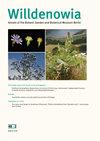始新世波罗的海琥珀的雄蕊花序和原位花粉揭示了壳斗科(橡树科)的高度多样性
IF 1.4
3区 生物学
Q2 PLANT SCIENCES
引用次数: 40
摘要
始新世波罗的海琥珀形成了世界上最大的琥珀矿床;然而,它的来源、植被和气候却有很大的争议。在波罗的海琥珀源地区,橡树科(壳子科)的代表植物非常丰富,这是基于大量雄蕊花序或单个小花的包含物,以前被分配给Castanea和Quercus。然而,波罗的海琥珀中壳斗科属和次属的实际多样性尚不清楚。利用花的特征和对雌蕊花序和离体小花包裹体的原位花粉切片诊断,我们描述了壳壳科的18个化石种,使壳壳科成为迄今为止在波罗的海琥珀中保存的最多样化的植物科。我们证实了Castaneoideae, Quercoideae(栎科). Cyclobalanopsis/Lobatae;阔叶叶节;Q. sect. Protobalanus), Trigonobalanoideae和已灭绝的Eotrigonobalanus属。18个化石种中有6个是新发现的,分别是:aimeeana、casparyi、multipilosa、campanulata、conwentzii、longianthera;并且发表了一个新的组合:Q. brachyandra(≡Castanea brachyandra)。此外,一个选择型被指定为Quercites meyerianus,新类型被指定为Castanea inclusa和Quercus longistaminea(≡C. longistaminea)。壳子科植物可能生活在琥珀源区的地带性和地带性植被类型中,包括洼地洪泛平原和河岸(Q. sect. Lobatae)、干燥生境(Q. sect. Lobatae, Q. sect. Protobalanus)、泥炭土、河岸和沼泽林(Castanopsis, Eotrigonobalanus)以及混合叶生林(castanoids, Quercoideae, trigonobalanids)。与现存的北美和东至东南亚植物群的相似性支持了最近的观点,即晚始新世波罗的海琥珀(38-34 Ma)形成于暖温带气候。引用本文:Sadowski e - m。[4]李春华,李春华,李春华,等。2010:中国栎科植物花粉多样性研究进展。-野生动物学报50:405-517。doi: https://doi.org/10.3372/wi.50.50303 2020年12月1日首次在线发布的记录版本,随后将被纳入2020年12月号。本文章由计算机程序翻译,如有差异,请以英文原文为准。
Staminate inflorescences with in situ pollen from Eocene Baltic amber reveal high diversity in Fagaceae (oak family)
Abstract: Eocene Baltic amber forms the largest amber deposit worldwide; however, its source vegetation and climate are much debated. Representatives of the oak family (Fagaceae) were abundant in the Baltic amber source area based on numerous inclusions of staminate inflorescences or individual florets, previously assigned to Castanea and Quercus. However, the actual generic and infrageneric diversity of Fagaceae from Baltic amber remained unknown. Using flower characteristics and section-diagnostic in situ pollen of staminate inflorescences and detached floret inclusions, we describe 18 fossil-species of Fagaceae making this family by far the most diverse plant family preserved in Baltic amber. We substantiate the occurrence of the Castaneoideae, Quercoideae (Quercus sect. Cyclobalanopsis/Lobatae; Q. sect. Lobatae; Q. sect. Protobalanus), Trigonobalanoideae and the extinct genus Eotrigonobalanus. Among the 18 fossil-species, six are described as new: Q. aimeeana, Q. casparyi, Q. multipilosa, E. campanulata, E. conwentzii, E. longianthera; and one new combination is published: Q. brachyandra (≡ Castanea brachyandra). In addition, a lectotype is designated for the name Quercites meyerianus and neotypes are designated for the names Castanea inclusa and Quercus longistaminea (≡ C. longistaminea). Members of the Fagaceae probably inhabited azonal and zonal vegetation types of the amber source area, including bottomland flood-plains and stream banks (Q. sect. Lobatae), dry habitats (Q. sect. Lobatae, Q. sect. Protobalanus), peaty soils, riparian and swamp forests (Castanopsis, Eotrigonobalanus), as well as mixed mesophytic forests (castaneoids, Quercoideae, trigonobalanoids). Affinities to extant North American and E to SE Asian floras support the recent notion that late Eocene Baltic amber (38–34 Ma) was formed in a warm-temperate climate. Citation: Sadowski E.-M., Schmidt A. R. & Denk T. 2020: Staminate inflorescences with in situ pollen from Eocene Baltic amber reveal high diversity in Fagaceae (oak family). – Willdenowia 50: 405–517. doi: https://doi.org/10.3372/wi.50.50303 Version of record first published online on 1 December 2020 ahead of inclusion in December 2020 issue.
求助全文
通过发布文献求助,成功后即可免费获取论文全文。
去求助
来源期刊

Willdenowia
PLANT SCIENCES-
CiteScore
4.60
自引率
5.30%
发文量
17
审稿时长
>12 weeks
期刊介绍:
Willdenowia is an international peer-reviewed journal publishing original research articles in English from the entire fields of plant, algal and fungal systematics, covering the evolution, taxonomy and nomenclature of these organisms as well as related fields such as floristics and plant geography. Articles on phylogeny and molecular systematics are especially welcome, as are review articles. Descriptions of new taxa may be considered, but only if supported by robust evidence. Narrowly regional studies of widespread taxa, routine typifications, checklists and new floristic records are generally not considered (excluding contributions to the Euro+Med-Checklist Notulae). Authors are encouraged to deposit duplicates of their material, especially nomenclatural types, in the Berlin herbarium (B).
 求助内容:
求助内容: 应助结果提醒方式:
应助结果提醒方式:


